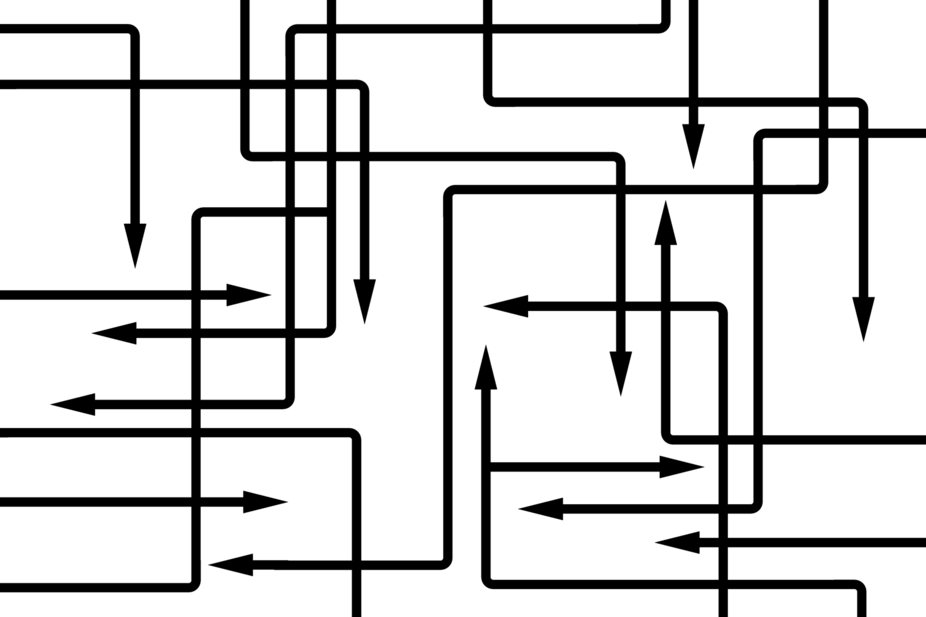Human activity has radically altered the nature of circulation flows. In the past, these patterns of movement depended directly on the natural environment: wind, river and ocean currents, the shifting of matter and living organisms, etc.
Today, we are living in an entirely new world. Circulation flows are increasingly dependent human activity, as illustrated by phenomena such as the large-scale transport of goods and people by road, rail, river, sea and air, the movement of new, mass produced material, such as waste, and the rapidly accelerating dematerialization of flows of information and money, for instance.
The illusion of control
More so than the natural flows we have attempted to master, with mixed results, the flows produced by human activity give us the illusion of control. Because humans set them in motion, there is a general feeling that we are capable of stopping these movements.
Numerous systems have been built around this illusion of control. Whether it is the flow of waste, information or capital, all flows ought to be able to be directly controlled by humans. But this is an illusion. Stakeholders – that is, States, businesses and individuals – are increasingly overwhelmed by the movements that they themselves triggered.
A key example: greenhouse gases
Greenhouse gases are a perfect illustration of this loss of control. Human activity has resulted in gas emissions that are beyond the reach of humans once released into the atmosphere. These gases accumulate and travel around the planet, and those who released them have no power to retrieve them.
Our only choice therefore is to wait until the existing gases dissipate (very slowly) over time, and try to reduce current and future emissions. But attempts at emission reduction are constrained by significant difficulties. It is not enough, for example, for one company or person to drastically reduce emissions. Everyone must take action if we want emission reduction to produce the desired effect worldwide.
A big-picture explanation: the technosphere
In a kind of snowball effect, circulation flows triggered by humans are increasingly beyond anyone’s control. This situation can be explained through a concept that physicists have named “the technosphere”, a term that covers all things produced by human technology since the dawn of humanity.
It includes interwoven systems of communication, transport, raw material use, energy production, industrial processing, modern agriculture, and bureaucracy. The impact of human technology is measured in ages and researchers have even estimated its weight at several billion tons worldwide.
This theory is still relatively controversial in scientific circles. For its adherents, these various technologies constitute a whole – a sphere – that threatens the balance of the biosphere that prevailed when life appeared on earth.
The concept of a new technological sphere ties directly into the idea that man-made flows are now beyond human control. If all the material and structures produced by humans constitute a whole, it follows that humans are overwhelmed by this new, uncontrollable environment. Humans are now forced to live with the technology they have created, and there is no turning back.
Humans have lost control of the technosphere. If we assume that the technosphere, like the biosphere, is made up of a multitude of interactions, i.e. flows, it is safe to say that we have lost control of circulation flows.
In the age of the Anthropocene, rethinking governance models is crucial
The fact that humans are increasingly confronted with situations beyond their control calls into question the sustainability of a number of our current modes of governance.
On a whole range of highly topical subjects, public discourse, and especially right-wing discourse, is still essentially based on the idea that people control circulation flows, particularly the flows of information, capital and waste.
Rather than imagining, as we pretend to believe today, that flows are largely controlled by humans, save for exceptional accidents, we have to look for alternative approaches. This implies a radical change in our outlook.
Humans are faced with the phenomenon of massive, rapid, circulation flows involving a multitude of participants. This is the case in areas as important as the total, uncontrolled flows of information, capital and waste. The hypothesis of total, uncontrolled circulation draws on around 40 years of research around the idea of a new geological era, the Anthropocene, following on from the current era, the Holocene. Both are shaped by the phenomenon of flows that are largely beyond human control, meaning that their study can be linked to the generally overlooked question of total, uncontrolled flows.
The flow of information is singular in this respect.
These complex phenomena pose a risk and may lead to crises. They must therefore be analyzed as such. We must take a fresh look at the way this risk and these potential crises can be managed, whether individually or collectively, publicly or privately, on a local, national or international scale.
Translated from the French by Alice Heathwood for Fast for Word.


